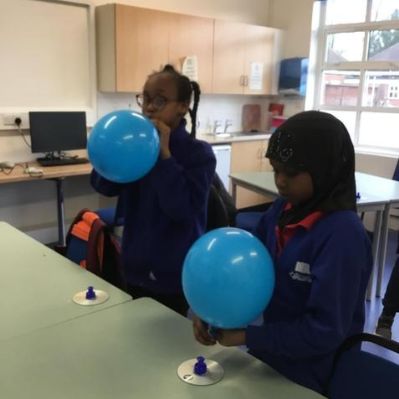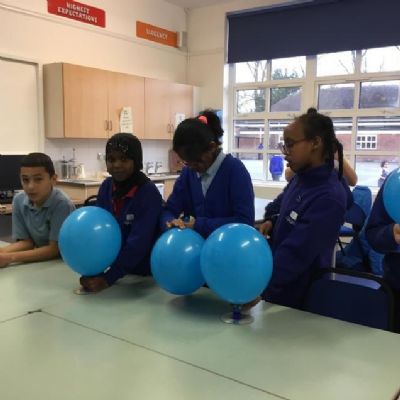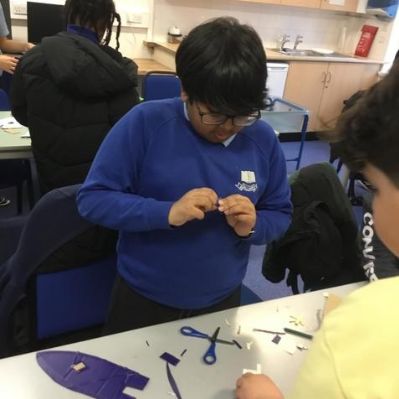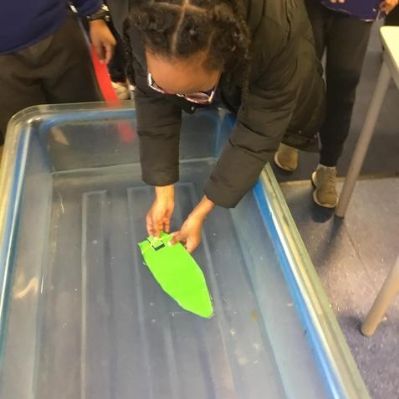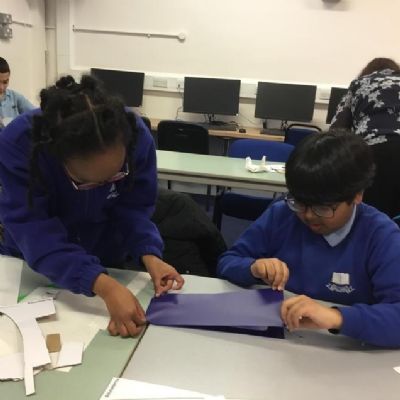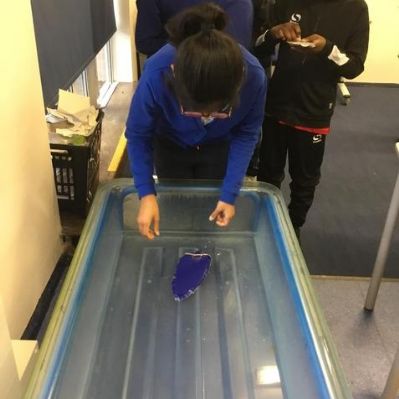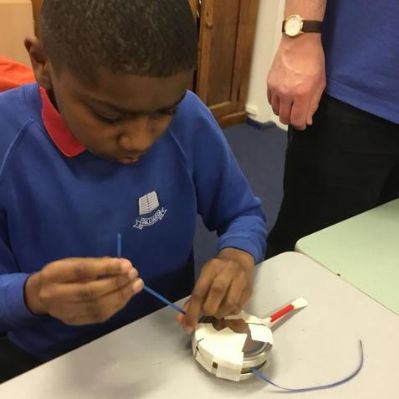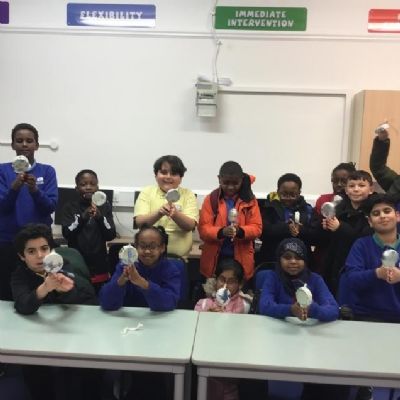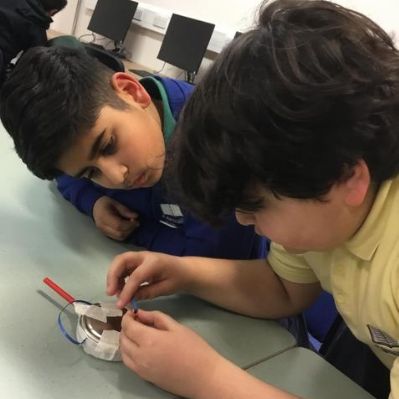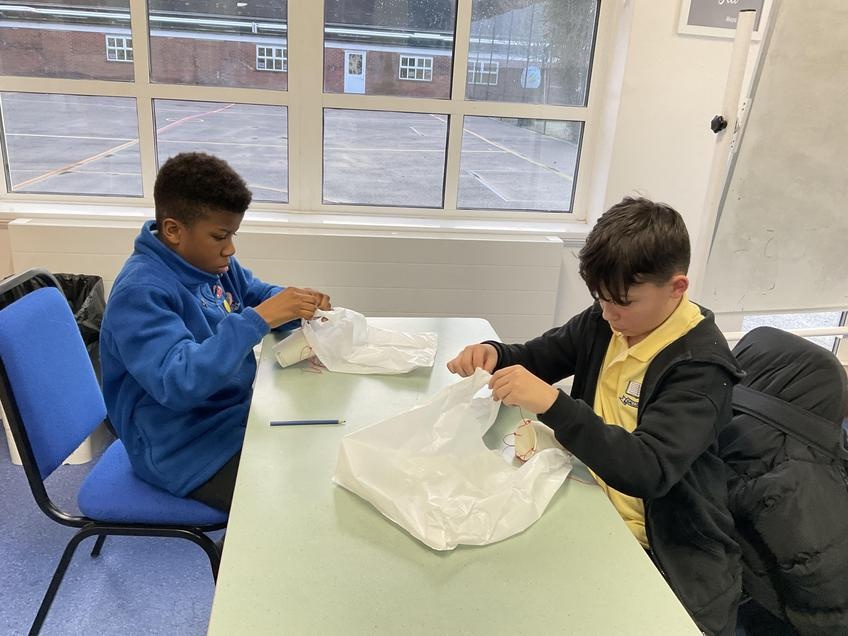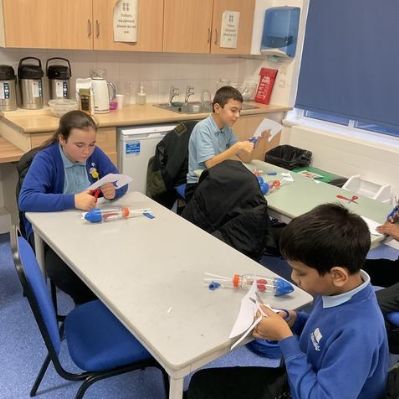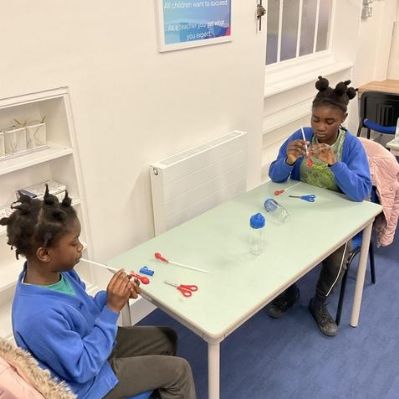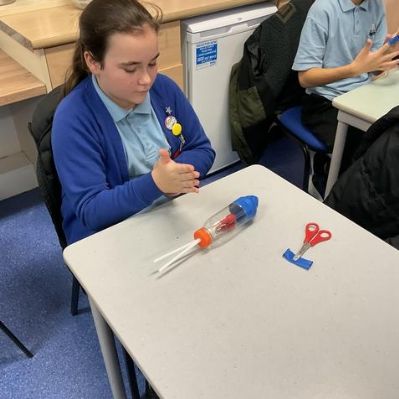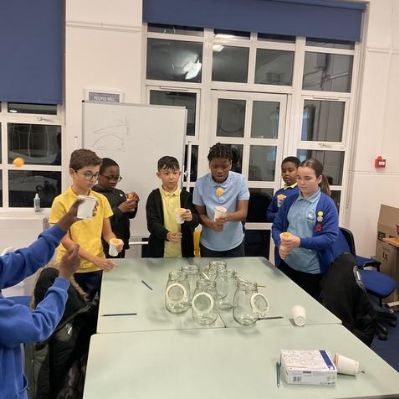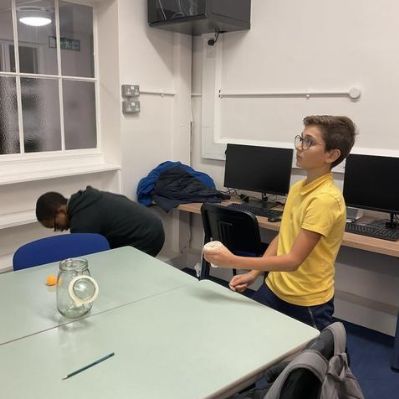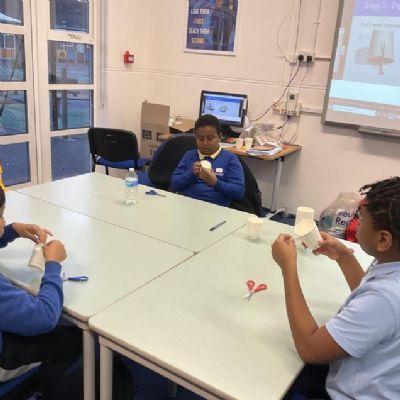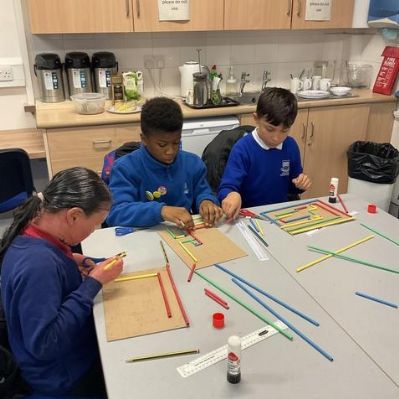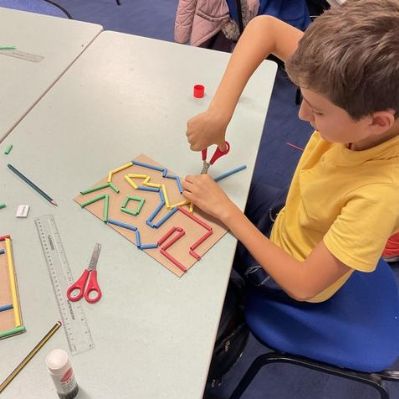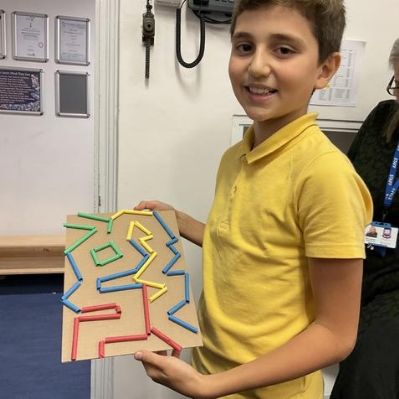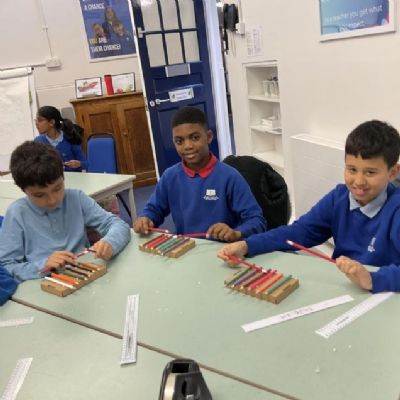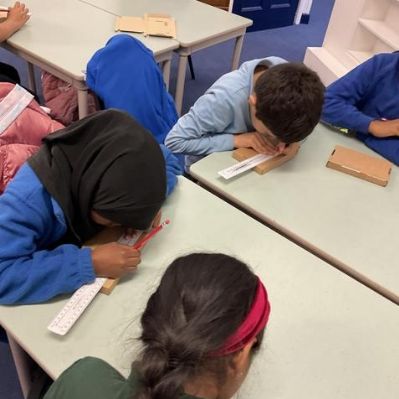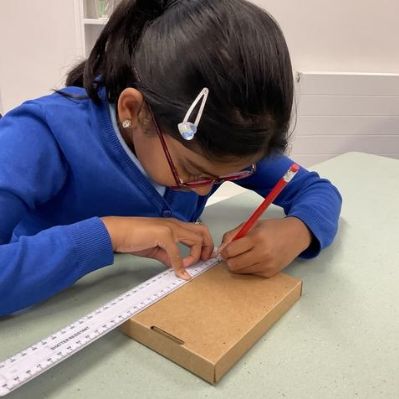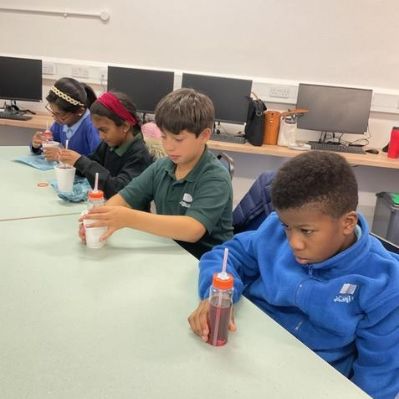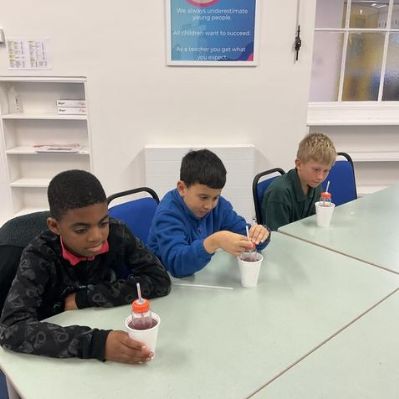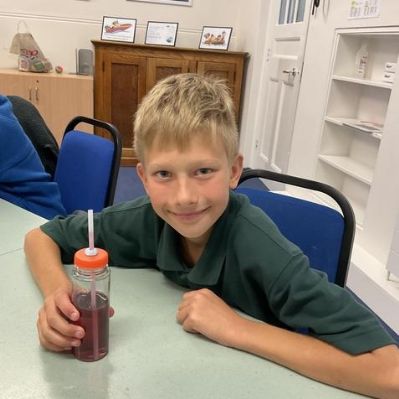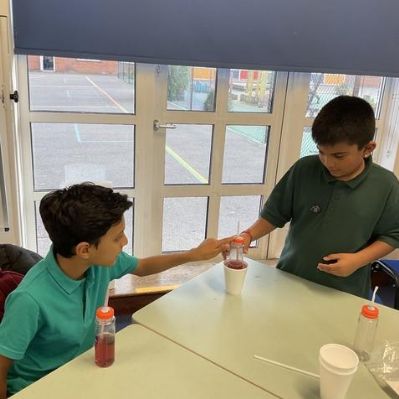STEM Club
WEEK ENDING 03/05/2024
Hoop Glider
This week at STEM club, the children made a hoop glider - this is a homemade paper aircraft that uses the four forces of flight to fly:
-
It has curved surfaces on the top give it lift
-
Its aerodynamic shape reduces drag
-
Gravity pulls the glider to the ground
-
Your arm provides thrust when you throw it
"I made two hoop gliders, one big one and one small one, to see which one would fly further. I predicted that the smaller one would go further but the longer one with bigger hoops went further!" Mahammud 5S
"I made one with two hoops and another one with 3 hoops. I predicted that the one with 3 hoops wouldn't fly as well. It did fly but it went in a different direction." Abdihafid 6W



WEEK ENDING 01/03/2024
Spinning toy
Today in STEM club the children enjoyed learning about magnets and used them to create a spinning toy.
How the toy works
The magnet inside the controller box repels the magnet on the toy whilst friction tries to keep it in place. The magnet inside the controller is positioned at an angle which tilts the toy slightly so the base starts to spin.
Interesting facts about magnets
-
If you cut a magnet in half, each part will behave like a new magnet, with its own north and south poles.
-
Most man-made magnets lose their magnetic characteristics over time, especially when hit (e.g. dropped or hammered) or heated, however we still classify them as permanent magnets.
-
Scientists measure magnetic fields with an instrument called a magnetometer


WEEK ENDING 02/02/2024
Basketball Game
Today in STEM club the children had lots of fun learning about levers and different types of energy whilst making a basketball game.
"This lesson was great because we learnt about different types of energy such is kinetic energy which is moving energy, potential energy, which is energy that is stored and ready to use. I like how you can shoot the ball and it was a really fun project." Shaina 5B
"It was really fun making the ball shooting mechanism. I needed to improve the placement of the ball holder and the popsicles to make it work." Mikaeel 5S



WEEK ENDING 19/01/2024
Rubber Band Race Car
Today in STEM club the children enjoyed making a rubber band race car! They learnt all about elasticity and how the maximum force at which a material is still elastic is called elastic limit. They discussed whether friction is good or bad and also learnt that potential energy describes energy that is stored and ready to be used.
"It's my first time at STEM club and I really enjoyed it because I learnt what two types of energy are (potential energy and kinetic energy) and I know what STEM actually means. I learnt how friction works too." Sameeah 5B




WEEK ENDING 24/11/2023
Centrifugal sprinklers
Today in STEM club the children learnt about centripetal and centrifugal forces. They watched a demonstration of centripetal force in action as a bucket of water was swung in a circular motion and they also thought about some everyday examples of these forces. They made a centrifugal sprinkler which they used to water the plants in the playground.
"Today we made a centrifugal sprinkler. A centrifugal force is a force where something is moving in a circular motion and pushes things out. With our sprinkler, we spin the centre stick to make a centrifugal force which pushes the water out so you can irrigate your crops." Shaina 5B
"I liked this session because we made water sprinklers to help crops grow. The force it uses is called centrifugal force." Zion, 6K
"Miss Carrington swung a bucket around because centripetal force pulls an object towwards the centre. The water was being pulled to the centre of the bucket so it didn't spill. Also, this is what pulls the Earth into orbit around the Sun." Mikaeel, 5S
"This was so much fun because we went outside and tested our sprinklers. The water came out quickly and sprayed everywhere." Stefanie 5S

WEEK ENDING 20/10/2023
Thaumatrope
Today in STEM club, the children learnt that light is a form of energy which travels in straight lines and that we need light in order to see things. They also learnt that our pupils get bigger in dim lighting allowing more light into the eyes making it easier for us to see.
The children then made a thaumatrope which is toy that was popular in Victorian times. When the two discs rotate quickly, our eyes can see one picture after the other and blend the two together creating an interesting effect.

WEEK ENDING 14/10/2023
Pulley system
At STEM club today, the children learnt about simple mechanisms and made their own pulley system. They used their maths skills to measure where to put holes accurately and demonstrated great team working skills when assembling their mechanisms.
"This is the best lesson ever because it's trial and error and you get to learn different things while you make something." Daijon, 5S



WEEK ENDING 06/10/2023
Harmonica
In STEM club this week, the children enjoyed learning about sound and making their own harmonica.
The children learnt about the 4 main classes of instruments:
● Aerophones - musical instruments that produce sound by causing a body of air (in most cases inside the instrument) to vibrate. They are usually called 'wind instruments', e.g flute.
● Chordophones - string instruments, e.g. a guitar.
● Idiophones are musical instruments that create sound by the vibration of the instrument itself, e.g. a xylophone.
● Membranophones produce sound by vibrating a stretched membrane, e.g. a drum.
“STEM is about making and building. S is for Science, T is for technology, E is for engineering and M is for maths." Zion 6K
“My harmonica works because sounds are made by vibrations. When I blow my harmonica, the paper in the middle goes up and down because it is vibrating.” Jannat, 5S
“Today I learnt something new, I learnt that sound travels 343 metres per second. I made a harmonica and I love music.” Stefani, 5S
“I didn't know a harmonica was a thing until I made it!” Hatun, 5M


WEEK ENDING 07/07/2023
Chromatography
In STEM club this week, we learnt about chromatography and made some flowers using filter paper, felt tip pens and water spray bottles.
"This is good for mental health because it's a very calm, relaxing and peaceful activity."
Riley 5B
WEEK ENDING 05/05/2023
Jellyfish in a bottle
Today in STEM club we learnt some interesting facts about jellyfish and made a 'jellyfish in a bottle'. When you squeeze the bottle, the 'jellyfish' sink to the bottom and when you release it, they float to the top.
Did you know...
- Jellyfish are invertebrates (unlike fish)
- The Immortal Jellyfish can reverse its life cycle
- The Box Jellyfish is considered to be the most venomous marine animal in the world
- Jellyfish are 95% water
- Jellyfish have no heart, brains, blood or bones
- Groups of jellyfish are called blooms


WEEK ENDING 21/04/2023
Balloon Hovercrafts
This week in STEM club we made a balloon hovercraft. A hovercraft is a vehicle that can glide over a smooth surface by hovering on an air cushion. A hovercraft can travel over land, water, mud (like a swamp), ice and other surfaces.
A hovercraft uses blowers to produce a large volume of air below it to form an air cushion. The difference between the higher air pressure below the hovercraft and the lower air pressure above it produces lift. This is what causes the hovercraft to float above the surface.
"Our hovercraft works by blowing up the balloon - the air inside is called potential stored energy. When this is released, the air pushes down out of the balloon which makes the CD lift up." Kayan 6P
Week Ending 10/03/2023
Paddle Boats
Today in STEM club we made a paddle boat. We learnt about buoyancy which is a force on an object making that object rise or move upward. Did you know that the word comes from the Spanish word for "float", boyar?
We also learnt about Newton's Third Law of Motion which states that for every action, there is an equal and opposite reaction. What this means is that pushing on an object causes that object to push back against you, the exact same amount, but in the opposite direction.
"My paddle boat has a motor - once it's wound up, it has a stored energy called potential energy. Once you let go, there will be not just one force but two. The motor pushes backwards and the boat pushes forward. This is called Newton's third law of motion". Barbod 6W
To find out more about Isaac Newton's laws of motion, click here:
Week ending 24th February 2023
Spin Drums
This week in STEM club we made a spin drum. We learnt that sounds are made when an object vibrates. This makes the air around the object vibrate too and the vibrations travel to our ear. Pitch is how high or low a sound is and this depends on the speed of the vibrations. This is measured in hertz or kilohertz.
We also learnt that instruments can be grouped according to how the sound is produced.
"I learnt how to make an instrument - a spin drum. This is an idiophone. It makes the sound because when spun ,the bead carried by the string will hit the metal which will vibrate the air around it making a sound."
Barbod 6W.
"Today I learnt that sound is made by vibrations. People can hear sound that is between 20 hertz and 20 kilohertz"
Yusuf 6M
Week ending 27th January 2023
This week at STEM club we made a parachute and learnt about the forces that act on it as it falls.
“This session was fun because we made a parachute. When the parachute is in the air, gravity pulls it down but the bag creates air resistance which is a type of force which slows the parachute down." Elijah, 6P
"I liked the part where we tested it out. I have learnt that when the parachute comes down, gravity is pulling it down and air resistance is pushing up and slowing it down." Daniella 6W
Week Ending 20/01/2023
This week in STEM club we made a breathing machine to show how our lungs work. Our lungs are an amazing machine with approximately 2,400 km of airways and 300 to 500 million alveoli (tiny air bags)!
"The blue balloon represents the diaphragm which is a special muscle in our body which helps us to breath. When you pull the blue balloon, it tightens and the red balloons fill with air. These are our lungs. When we let go of the blue balloon our lungs deflate. The bottle represents our rib cage which protects our lungs." Elijah, 6P
"When you breathe in, you breathe in oxygen and this is carried in your red blood cells to your important organs. The heart pumps the blood around your body. When we breathe out, we breathe out carbon dioxide." Chidubem, 6M
Did you know …
- Some snails have lungs too
- Our right lung is bigger than our left lung
- An average person breathes in around 11,000 litres of air every day
Week ending 2nd December
The children had a lot of fun this week making a Ball Shooter. They learnt how energy gets stored in the rubber band as they pull the string (this is called potential energy) and how this energy is transferred into the kinetic energy of the ball as the string is released. They also learnt about the following scientists:
- Marie de La Condamine discovered rubber in 1736
- Joseph Priestley observed that a piece of rubber was extremely good for rubbing off pencil marks on paper in 1770, in England.
"This session was the best session I've been to because it was fun and I learnt at the same time. I learnt that Joseph Priestly invented the rubber which we use today." Abdihafid 5B
"This is the first club I've been to and I love it because we get to take our models home. I played with my Ball Shooter with my sisters." Rayyan 5B
"I think STEM club is a good opportunity to learn new words, for example elasticity, plasticity, potential energy and kinetic energy. My sister really enjoyed playing with my Ball Shooter and I taught her what gravity was." Summer 6P
"I like STEM club because you learn and create things." Luka 6P
Week Ending 25/11/2022
In STEM club this week, we learnt about the scientist Isaac Newton who discovered gravity. We then designed and made our own marble run. We tested them out and talked about what forces were acting on the marble.
"I liked making the marble run because it was creative and fun. I learnt more about gravity and friction and how they work." Sonny 6W
"I have learnt to never give up - I designed a complicated marble run with curved edges but went with my gut and it worked!" Luka 6P
Week Ending 04/11/2022
This week at STEM club we learnt about pneumatics and hydraulics and made a hydraulic bridge. Pneumatics is the use of pressurised air to make things move and hydraulics is the use of pressurised water to make things move. Pneumatics and hydraulics are found in machines such as diggers and concrete breakers, bicycle pumps and door openings on buses and trains.
Watch the video below to see Morgan in 6P demonstrate how his hydraulic bridge works.
Week Ending 14/10/2022
In STEM club this week we made a pencil xylophone. We learnt that sounds are made when something vibrates and that the pitch of a sound is how high or low the sound is.
Different objects produce different pitches depending on the speed of the vibrations:
If an object vibrates quickly, we hear a high-pitched sound.
If an object vibrates slowly, we hear a low-pitched sound.
We also learnt that instruments can be divided into 4 main groups:
● Aerophones are musical instruments that produce sound by causing a body of air (in most cases inside the instrument) to vibrate. They are usually called 'wind instruments', e.g a flute.
● Chordophones are string instruments, e.g a guitar.
● Idiophones are musical instruments that create sound by the vibration of the instrument itself, e.g. a xylophone.
● Membranophones produce sound by vibrating a stretched membrane, e.g. a drum.
Did you know?
The denser (thicker) the medium, the faster the sound travels.
Sound travels through air at 343 metres-per-second!
Sound travels through water at 1,482 metres-per-second!
Sound travels through steel at 4,512 metres-per-second
“I learnt that sound is made by vibrations and it travels slower than light. I used maths to measure where 2.5cm was on my box because the gaps between the pencils were 2.5cm. I like how everything we make involves science, technology, engineering and maths.” Riley 5B
“I liked learning about the different types of instruments. An aerophone is a wind instrument, a chordophone is a string instrument, an idiophone is an instrument that vibrates itself and a membranophone is a drum.” Nyle 5B
“I like STEM club because you make things and you also learn a lot of things. We learnt a lot about sound – I liked experimenting with my xylophone at home and I made different tunes.” Nooriyah 5B
Week Ending 07/10/2022
This week at STEM Club we made a periscope. This is something people use to look at things from a hidden position. First we used a mirror and looked at how it reflected the sun. Then we made a cuboid and put mirrors at each end. They were at a 45-degree angle and the light reflected off them and into our eyes so we could see. Periscopes are used in submarines and were also used during World War One.
Did you know?
Periscope comes from two Greek words - “Peri” means “around,” and “scopus” means "to look.”
By Jakub, Ayman and Nischal 6P
"I liked that I could look around areas - I looked around corners and spied on my brother at home!" Ayman 6P
Week Ending 30/09/2022
This week the children learnt about temperature and how thermometers work. They discussed what happens to particles at higher and lower temperatures and found out about some famous scientists including Daniel Gabriel Fahrenheit, Andus Celcius and William Thomson. The children then made their own thermometers using a bottle, straw, Blu Tack and some coloured water and enjoyed testing them out.
Yug in 6P explains how his homemade thermometer works:
"When I put the thermometer in the hot water, all the particles got warmer and started to move around faster which made the liquid expand."
Luke - could you add this bit at the end too and put it in a text box maybe as a little fun facts section ...
DID YOU KNOW?
The core of the Sun can reach 15 million degrees Celcius!
Lightning can reach temperatures of 27,760 to 38, 871 °C
The temperature at the Earth's inner core surface is estimated to be approximately 5,430 °C.
Liquid hydrogen is the coldest substance known to man at-252.87 °C
The highest recorded temperature in the UK is 40.3° C recorded in Coningsby, Lincolnshire on 19th July 2022.
Week Ending 23/09/2022
The children’s first project was to make a robotic arm/grabber! This involved learning about the properties of a rhombus and the functions of a lever and a pivot. The children thoroughly enjoyed making their models and testing them out by trying to pick up a pom pom. They then came up with ideas of what they could use their robotic arm for at home. We're looking forward to seeing what the children will be making next week!
"I enjoyed making the pivots and the levers for the grabbers and it was so much fun testing it out with the pom pom. When I got home, I used my grabber to pick up some trash from the floor and I put it in the bin." Morgan, 6P
"I love learning about making things because I'm a DIY person. In STEM club you can learn and make things at the same time." Kayan, 6P
"I really liked it because when I grow up, I want to be an engineer and so this club is helping me to learn lots about it." Nischal, 6P
"It was lots of fun and I loved making the robotic arm with the levers and I liked using it at home." Hanisha, 5T






